What is JSON Web Token?
JSON Web Token (JWT) is an open standard (RFC 7519) that defines a compact and self-contained way for securely transmitting information between parties as a JSON object. This information can be verified and trusted because it is digitally signed. JWTs can be signed using a secret (with the HMAC algorithm) or a public/private key pair using RSA or ECDSA.
When should you use JSON Web Tokens?
Here are some scenarios where JSON Web Tokens are useful:
Authorization: This is the most common scenario for using JWT. Once the user is logged in, each subsequent request will include the JWT, allowing the user to access routes, services, and resources that are permitted with that token. Single Sign On is a feature that widely uses JWT nowadays, because of its small overhead and its ability to be easily used across different domains.
Information Exchange: JSON Web Tokens are a good way of securely transmitting information between parties. Because JWTs can be signed—for example, using public/private key pairs—you can be sure the senders are who they say they are. Additionally, as the signature is calculated using the header and the payload, you can also verify that the content hasn’t been tampered with.
JSON Web Token structure
In its compact form, JSON Web Tokens consist of three parts separated by dots (.), which are:
Header
Payload
Signature
Therefore, a JWT typically looks like the following.
xxxxx.yyyyy.zzzzz
Header
The header typically consists of two parts: the type of the token, which is JWT, and the signing algorithm being used, such as HMAC SHA256 or RSA.
For example:
“alg”: “HS256”,
“typ”: “JWT”
}
Payload
The second part of the token is the payload, which contains the claims. Claims are statements about an entity (typically, the user) and additional data.
For example:
“userId”: “1234567890”,
“name”: “John Doe”
}
Signature
To create the signature part you have to take the encoded header, the encoded payload, a secret (a generated string, or ), the algorithm specified in the header, and sign that.
For example if you want to use the HMAC SHA256 algorithm, the signature will be created in the following way:
base64UrlEncode(header) + “.” +
base64UrlEncode(payload),
secret)
Eg:.
signature = Hash(data, secret);
Secret Key Generate
Random secret key can be easily generated in cli (script was found here Generate a Random JWT Secret Key – by Tonny Kirwa)
If you want to play with JWT and put these concepts into practice, you can use jwt.io Debugger to decode, verify, and generate JWTs.
More detail about how jwt work can be found in this original source JWT introduction





